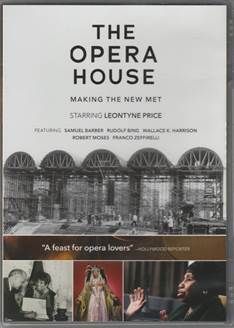
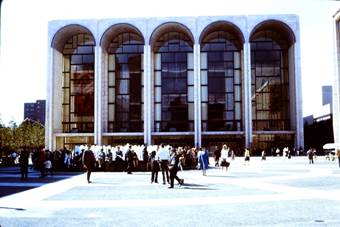
Available from the metoperashop.org. (click here)
THE OPERA HOUSE, making the new Met starring Leontyne Price; a Susan Froemke Film


Available from the metoperashop.org. (click here)
This DVD is a product of the 50th anniversary of the Metropolitan Opera’s move to its new theatre at Lincoln Center from its old Broadway andWest 39th Street opera house. Although the DVD is Met and New York City-specific, the cast is international and the story told has wide appeal. It was brilliant that Ms. Froemke was able to enlist 90-year old Leontyne Price to narrate the story. Miss Price, who in recent years has been fairly low-profile, turns in a true diva performance as narrator, full of humor and is non self-deprecating; the lady knows her worth!
The DVD traces the many efforts over the years, going back the 1908, for a more luxurious and modern theatre. There was the Otto Kahn dream in 1908, and the hope to incorporate a new Met in the 1930’s Rockefeller Center project. For various practical, political and financial reasons these projects never got off the drawing boards, but renderings of these dream plans exist and are pictured in this DVD with salient commentary.
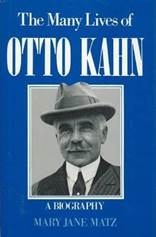
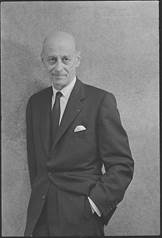
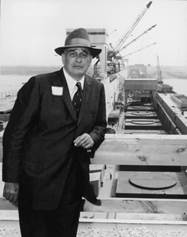
(Otto Kahn, Rudolf Bing, Robert Moses)
Then the DVD becomes a very New York City story and the towering presence of Robert Moses, the legendary New York City city-planner who masterminded several projects, airports, expressways, parks, over the years to make New York City a true Empire City. His broad vision necessarily and unfortunately involved tearing up neighborhoods to achieve his ends. We are introduced to men in their sixties and older who reminisce about their immigrant community that was being destroyed to make way for the new Lincoln Center. There is archival footage of a poor but vibrant life that had to be destroyed to make way for the new. This always happens when projects, supposedly for the greater good, have a sad back story.
The DVD dwells on the architectural challenges the Lincoln Center project presented. An eminent architect, Wallace Harrison, was engaged to design the Metropolitan Opera component of Lincoln Center, but his original opulent design for the opera house had to be trimmed down in order to better blend with the planned Philip Johnson-designed New York State theatre and the Max Abramowitz-designed Philharmonic Hall. Fifty-plus years later it is interesting to note that conservative financier David Koch’s name adorns now the State Theatre and pop-record producer David Geffen Philharmonic Hall. The arts in America always need money, and wealthy patrons who made huge contributions also acquired naming rights.
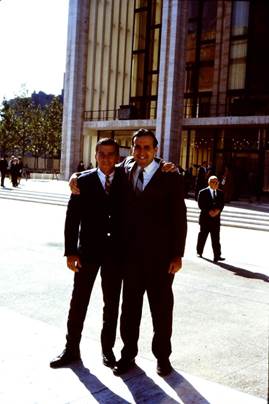
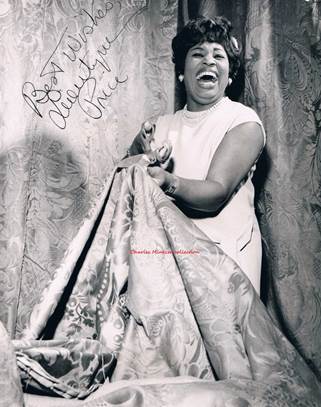
(Charles Mintzer and Arthur Naftal at the opening of the new house, Leontyne Price seems to be getting quite a kick of cutting the first swatch from the old Met’s famous golden curtain, 18 July 1966)
For the opera-lover not particularly interested in the politics and aesthetics of the building of Lincoln Center there is short, rare footage of a 1959 “Macbeth” rehearsal with Leonard Warren and Leone Rysanek, not a celebrated aria, but just some recitative that demonstrates to people who never heard Warren in person what a tremendous voice and artist he was. I have always found it puzzling that younger opera lovers and others dismiss Warren based on recordings. I wasn’t even his greatest fan, but believe me, that voice was, to use the cliché, a force of nature.
In 1959, when I was attending Columbia University as a graduate student, I went down to the area that was to become Lincoln Center for the groundbreaking. I have vivid memories, confirmed by footage in this DVD, of President Dwight Eisenhower symbolically shoveling the dirt and speaking of the enormity of the occasion. Leonard Bernstein conducted the New York Philharmonic in appropriate numbers and Leonard Warren and Rise Stevens sang, if memory serves me, the “Pagliacci” Prologue and the “Carmen” Habanera.
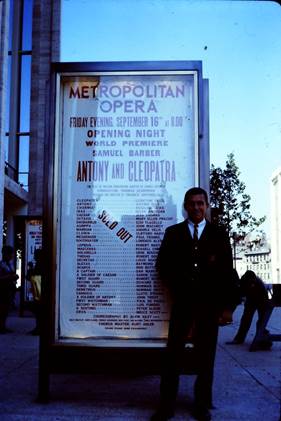
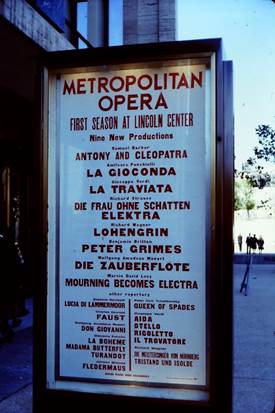
With the historical aspects of the new theatre covered, the DVD turns to the Met itself. Enter Leontyne Price who was chosen by Rudolf Bing to open the new house with an opera commissioned for the occasion and an American dream cast. Leontyne Price and Justino Diaz were chosen as Cleopatra and Anthony in the new Samuel Barber opera. An African-American soprano and a Puerto Rican bass-baritone represented the then American hopes of a new American diversity. Italian director and designer Franco Zeffirrelli, who had won the hearts of New Yorkers for his “Falstaff” a few years earlier, was brought in to produce what was hoped to be a blockbuster staging. On a personal note I sent a question to the Met’s Opera Quiz at the time asking if the panel could name the three sopranos who inaugurated America’s three leading new opera houses: the answer Rosa Raisa, “Aida” 1929 Chicago Civic Opera House, Claudia Muzio, “Tosca” 1932 San Francisco War Memorial Auditorium and Leontyne Price, the new Metropolitan Opera House. They did not use my question!
I am happy that the DVD takes note that the actual first performance at the new opera house was an April 1966 student performance of “Fanciulla” with Beverly Bower, Gaetano Bardini and Cesare Bardelli in the leads. I know of this performance as my late friend, the Met archivist Robert Tuggle was at that time the Education director of the Met Opera Guild and he oversaw this performance, held specifically to test the acoustics of the new theatre. He told me of the excitement for this successful experiment.
Before the “Anthony and Cleopatra” chapter we have a section on the closing and demolition of the old opera house. There is footage of the inadequate stage and storage facilities which were part of the reason a modern theatre was needed. The political struggle with advocates on both side of the issue is dealt with fairly. The closing night gala is well documented. There is rare archival footage of the gala closing night concert with Leopold Stokowski in the conductor’s pit turning to the audience with an ardent appeal to “save this house.” A side note: When a young friend doing some documentary film work needed inside-the-Met motion picture footage, I recalled that retired friends whom I had not been in touch with for several years took “unauthorized” motion pictures of the closing night, which included introductions of the retired singers, curtain calls, the “Aida” ballet sequence, etc. I put these friends in touch with Robert Tuggle of the Met Archives, and a copy of their films were turned over to the Met. You can imagine my delight that at least six of their fragments taken from a dress circle box on the right side now found their way on this DVD, including the famous Licia Albanese touching and kissing the stage floor in her impassioned gesture to “Save the Old Met.”
Click here for rare footage of the old house in 1938 + here
Click here for rare footage of the good-bye in 1966
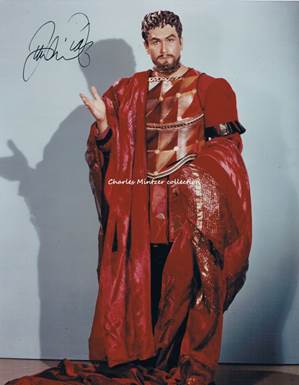
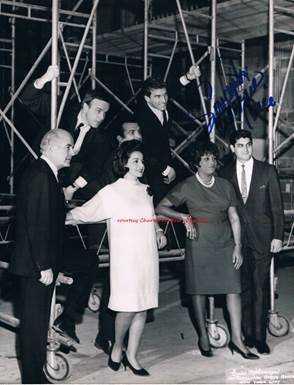
(Justino Diaz as Anthony, the principals : Samuel Barber, Franco Zeffirelli, Rosalind Elias, Jess Thomas, Thomas Schippers, Leontyne Price and Justino Diaz)
In setting up the “Anthony and Cleopatra” part of the DVD, Leontyne Price describes Mr. Bing’s autocratic style and her early journey as a young opera singer; she singles out Franco Corelli as the tenor she often sang with early in her career, waxing on his handsome appearance and sex appeal.
The DVD leaves a somewhat inaccurate impression that Samuel Barber wrote his “Knoxville: Summer of 1915” for Price as that is the music she sings in that context. But my research indicates that “Knoxville” was commissioned by and written for Eleanor Steber, and premiered it in 1948 with the Boston Symphony Orchestra and that Price came to be associated with the piece a bit later in its life. Price says that Samuel Barber asked her Julliard teacher, Florence Page Kimball, in the early ‘50s, to recommend perhaps one of her better students to premier his new opus, but that cannot be “Knoxville: Summer, 1915,” when what probably happened was he was looking for a fresh American talent to sing his 1953 cycle “Hermit Songs.” Still, it is glorious to hear Price sing the opening lines of “Knoxville” in her still remarkable, older voice.
There is very rare footage of the rehearsal process for the new Barber opera, with Franco Zeffirelli at his wits end dealing with the new, unreliable, revolving stage turntable not working as it should. As Leontyne sings her big aria at the filmed rehearsal, she sings along in her present voice, still glorious, and she reminds us that she was blessed with an extraordinary instrument. There is of course newsreel footage of the glamorous opening night with Lady Bird Johnson and Imelda Marcos in a center box hosting Leontyne’s parents who came up from Laurel, Mississippi for the occasion. Anyone with an appreciation of American history gets teary-eyed at these associations.
Click her Leontyne Price's interview on the opening night + click here to listen to/watch her in her great aria
Click here for footage of the problems with the production
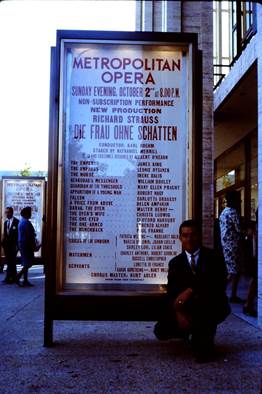
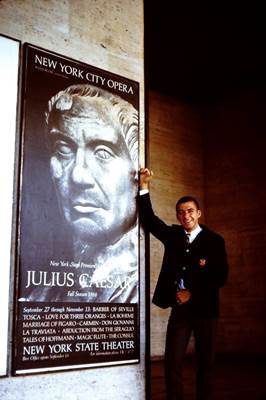
(Charles's friend, the late Arthur Naftal)
Finally, the 1966-67 season saw nine lavish new productions made specifically for the new, technologically-sophisticated Met, and Rudolf Bing saying it was way too ambitious, especially four of them in the first three week of the season, “Anthony,” “La Gioconda,” “Traviata,” and “Frau,” Think of it, Price, Tebaldi and Corelli, Moffo, Prevedi and Merrill and the icing on the cake, Rysanek, Ludwig, King, and Berry in lavish new productions. The others were “Elektra” with Nilsson, Marvin David Levy’s “Morning Becomes Elektra,” “Peter Grimes” with Jon Vickers, the Wieland Wagner-designed production of “Lohengrin” with Konya, Bjoner and Ludwig and the famous Marc Chagall production of “Zauberflöte” with Lorrengar and Gedda and the debut of Lucia Popp.
This DVD will bring tears to New York opera-goers and Americans who adore the Met, but I think this DVD also has universal appeal and will touch any opera lover with a sense of history and the preeminent place the Met held at that time in the opera world.
Charles Mintzer, October 2018 (all photos courtesy Charles Mintzer collection)